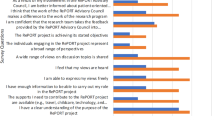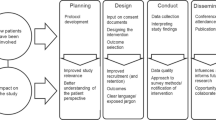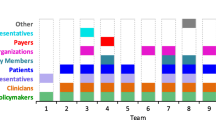Abstract
Objective
The aim was to describe barriers to patient and family advisory council (PFAC) member engagement in research and strategies to support engagement in this context.
Methods
We formed a study team comprising patient advisors, researchers, physicians, and nurses. We then undertook a qualitative study using focus groups and interviews. We invited PFAC members, PFAC leaders, hospital leaders, and researchers from nine academic medical centers that are part of a hospital medicine research network to participate. All participants were asked a standard set of questions exploring the study question. We used content analysis to analyze data.
Results
Eighty PFAC members and other stakeholders (45 patient/caregiver members of PFACs, 12 PFAC leaders, 12 hospital leaders, 11 researchers) participated in eight focus and 19 individual interviews. We identified ten barriers to PFAC member engagement in research. Codes were organized into three categories: (1) individual PFAC member reluctance; (2) lack of skills and training; and (3) problems connecting with the right person at the right time. We identified ten strategies to support engagement. These were organized into four categories: (1) creating an environment where the PFAC members are making a genuine and unique contribution; (2) building community between PFAC members and researchers; (3) best practice activities for researchers to facilitate engagement; and (4) tools and training.
Conclusion
Barriers to engaging PFAC members in research include patients’ negative perceptions of research and researchers’ lack of training. Building community between PFAC members and researchers is a foundation for partnerships. There are shared training opportunities for PFAC members and researchers to build skills about research and research engagement.



Similar content being viewed by others
References
Duffett L. Patient engagement: what partnering with patient in research is all about. Thromb Res. 2017;150:113–20.
Fagan MB, Wong C, Morrison CRC, Lewis-O’Connor A, Carnie MB. Patients, persistence and partnership: creating and sustaining patient and family advisory councils in a Hospital Setting. JCOM. 2016;23:219–25.
Pomey M, Hihat H, Khalifa M, Lebel P, Neron A. Patient partnerships in quality improvement of healthcare services: patients’ input and challenges faced. Patient Exp J. 2015;2:29–42.
Herrin J, Harris KG, Kenward K, Hones S, Joshi MS, Frosch DL. Patient and family engagement: a survey of US hospital practices. BMJ Qual Saf. 2015. https://doi.org/10.1136/bmjqs-2015-004006.
Wolf JA. A report of the Beryl Institute benchmarking study state of patient experience 2015. Southlake Texas: Beryl Institute; 2017.
Haycock C, Wahl C. Achieving patient and family engagement through the implementation and evaluation of advisory councils across a large health care system. Nurse Adm Q. 2013;37:242–6.
Fagan MB, Wong C, Carnie MB. Brigham and Women’s Hospital Patient and Family Advisory Council report. http://www.brighamandwomens.org/Patients_Visitors/patientresources/DPH_Report_Sept_2016.pdf. Accessed 07 Nov 2017.
Warren N. Involving patient and family advisors in the patient and family centered care models. MedSurg Nurs. 2012;21:232.
The Change Foundation. Patient/family advisory councils in Ontario hospitals: at work, in play. Part 1: emerging themes. http://www.changefoundation.ca/patient-family-advisory-councils-report/. Accessed 07 Nov 2017.
O’Leary KJ, Killarney A, Hanson LO, Jones S, Malladi M, Marks K, Shah HM. Effect of patient centered bedside rounds on hospitalised patients’ decision control, activation and satisfaction with care. BMJ Qual Saf. 2015. https://doi.org/10.1136/bmjqs-2015-004561.
Patient Centered Outcomes Research Institute (PCORI). What we mean by engagement. https://www.pcori.org/engagement/what-we-mean-engagement. Accessed 07 Nov 2017.
Domecq JP, Prutsky G, Elraiyah T, Wang Z, Nabhan M, Shippee N, et al. Patient engagement in research: a systematic review. BMC Health Serv Res. 2014;14:89.
Esmail L, Moore E, Rein A. Evaluating patient and stakeholder engagement in research: moving from theory to practice. J Comp Eff Res. 2015;4:133–45.
Sheridan S, Schrandt S, Forsythe L, Advisory Panel on Patient Engagement (2013 inaugural panel), Hillard TS, Paez KA. The PCORI Engagement Rubric: promising practices for partnering in research. Annals of Family Medicine. 2017;15:165–70.
Forsythe LP, Frank LB, Workman TA, Borsky A, Hilliard T, Harwell D, Fayish L. Health researcher views on comparative effectiveness research and research engagement. J Comp Eff Res. 2017;6:246–56.
Perez Jolles M, Martines M, Garcia SJ, Stein GL, Mentor Parent Group Members, Thomas KC. Involving Latina/o parents in patient-centered outcomes research: contributions to research study design, implementation and outcomes. Health Expect. 2017;00:1–9. https://doi.org/10.1111/nex.12540.
Holm KE, Casaburi R, Cerreta S, Gussin HA, Husbands J, Porszasz J, et al. Patient involvement in the design of a patient centered clinical trial to promote adherence to supplemental oxygen therapy in COPD. Patient Patient Cent Outcomes Res. 2016;9:271–9.
Concannon TW, Meissner P, Grunbaum J, McElwee N, Guise J, Santa J, et al. A new taxonomy for stakeholder engagement in patient centered outcomes research. J Gen Intern Med. 2012;27:985–91.
Fagan MB, Morrison CRC, Wong C, Carnie MB, Gabbai-Saldate P. Implementing a pragmatic framework for authentic patient-researcher partnerships in clinical research. J Comp Eff Res. 2016;5:297–308.
Auerbach A, Patel MS, Metlay JP, Schnipper JL, Williams MV, Robinson EJ, et al. The Hospital Medicine Reengineering Network (HOMERuN): a learning organization focused on improving hospital care. Acad Med. 2014;89:415–20.
Patton MQ. Qualitative research and evaluation methods. 3rd ed. Thousand Oaks: Sage Publications; 2002.
Forsythe LP, Ellis L, Edmundson L, Sabharwal R, Rein A, Konopka K, et al. Patient and stakeholder engagement in the PCORI pilot projects: description and lessons learnt. J Gen Intern Med. 2016;31:13–21.
Forsythe LP, Frank L, Walker KO, Wegener N, Weisman H, Hunt G, et al. Patient and clinician views on comparative effectiveness research and engagement in research. J Comp Eff Res. 2015;4:11–25.
Corbin J, Strauss A. Basics of qualitative research. 3rd ed. Los Angeles: Sage Publications; 2008.
Schreier M. Qualitative content analysis in practice. Los Angeles: Sage Publications; 2012.
Bradley EH, Curry LA, Devers KJ. Qualitative data analysis for health services research: developing taxonomy, themes and theory. Health Serv Res. 2007;42(4):1758–72.
Supple D, Roberts A, Hudson V, Masefield S, Fitch N, Rahmen M, et al. From tokenism to meaningful patient engagement: best practices in patient involvement in a EU project. Res Involv Engagem. 2015;1:5. https://doi.org/10.1186/s40900-015-0004-9.
Cottrell EK, Whitcock EP, Kato E, Uhl S, Belinson S, Chang C, et al. Defining the benefits and challenges of stakeholder engagement in systematic reviews. Comp Eff Res. 2015;5:13–9.
Acknowledgements
We would like to thank all stakeholders who participated in interviews and focus groups. Special thanks to all the patient partners for their time and for sharing their perspectives. Additional thanks for Tweedie Gaines, Ann-Marie Baker, Karen Anderson, Jason Selinger, Joanna Laffrey, and Teri Rose for assistance in organizing the focus groups. The statements presented in this publication are solely the responsibility of the authors and do not necessarily represent the views of the Patient-Centered Outcomes Research Institute (PCORI), its Board of Governors or Methodology Committee.
Funding
This study was funded by a Patient-Centered Outcomes Research Institute (PCORI) Eugene Washington Engagement Award (Harrison #3455).
Author information
Authors and Affiliations
Contributions
JDH, WGA, MF, ER, JS, GS, CH, MBC, JB, and ADA contributed to the concept, study design, study implementation, data collection, data analysis/interpretation and manuscript preparation. CW contributed to study implementation, data collection, data analysis/interpretation and manuscript preparation. SC and JD were involved in the data analysis/interpretation and manuscript preparation.
Corresponding author
Ethics declarations
Ethical approval
This study was reviewed and approved by the University of California San Francisco (UCSF), Brigham & Women’s Hospital (BWH), and Christiana Care Health System (CCHS) Committees on Human Research.
Conflict of interest
All authors support patient stakeholder engagement in research and patient-centered care. JDH, WGA, MF, ER, JS, GS, CH, MBC, JB, CW, SC, JD and ADA have no other conflicts of interest to declare.
Electronic supplementary material
Below is the link to the electronic supplementary material.
Rights and permissions
About this article
Cite this article
Harrison, J.D., Anderson, W.G., Fagan, M. et al. Patient and Family Advisory Councils (PFACs): Identifying Challenges and Solutions to Support Engagement in Research. Patient 11, 413–423 (2018). https://doi.org/10.1007/s40271-018-0298-4
Published:
Issue Date:
DOI: https://doi.org/10.1007/s40271-018-0298-4




